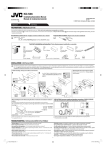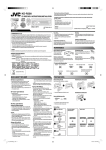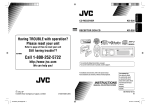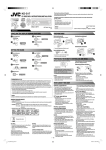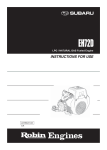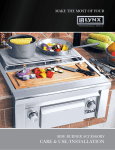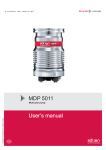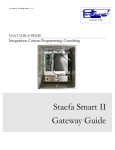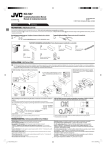Download JVC 0709DTSMDTJEIN CD Player User Manual
Transcript
KD-S16 CD RECEIVER: INSTRUCTIONS/INSTALLATION Thank you for purchasing a JVC product. Please read all instructions carefully before operation, to ensure your complete understanding and to obtain the best possible performance from the unit. Installation/connection are explained at the last section of this manual (reverse page, indicated with symbol). For customer Use: Enter below the Model No. and Serial No. which are located on the top or bottom of the cabinet. Retain this information for future reference. GET0641-001A [J] ENGLISH 0709DTSMDTJEIN Model No. Serial No. EN © 2009 Victor Company of Japan, Limited ESPAÑOL CANCELING THE DISPLAY DEMONSTRATIONS Turn on the power. Select “DEMO OFF.” PREPARATIONS How to reset your unit Attaching the control panel Reset the unit after installation is complete. Finish the procedure. (Initial setting) Detaching the control panel • Your preset adjustments will also be erased. SETTING THE CLOCK Turn on the power. How to forcibly eject a disc Select “CLOCK M.” • Be careful not to drop the disc when it ejects. • If this does not work, reset your unit. (Initial setting) Adjust the minute. Select “CLOCK H.” Finish the procedure. For safety... Warning • Do not raise the volume level too much, as this will block outside sounds, making driving dangerous. • Stop the car before performing any complicated operations. If you need to operate the unit while driving, be sure to look around carefully or you may be involved in a traffic accident. Caution on volume setting Temperature inside the car... Adjust the hour. If you have parked the car for a long time in hot or cold weather, wait until the temperature in the car becomes normal before operating the unit. Discs produce very little noise compared with other sources. Lower the volume before playing a disc to avoid damaging the speakers by the sudden increase of the output level. IMPORTANT FOR LASER PRODUCTS INFORMATION (For U.S.A.) This equipment has been tested and found to comply with the limits for a Class B digital device, pursuant to Part 15 of the FCC Rules. These limits are designed to provide reasonable protection against harmful interference in a residential installation. This equipment generates, uses, and can radiate radio frequency energy and, if not installed and used in accordance with the instructions, may cause harmful interference to radio communications. However, there is no guarantee that interference will not occur in a particular installation. If this equipment does cause harmful interference to radio or television reception, which can be determined by turning the equipment off and on, the user is encouraged to try to correct the interference by one or more of the following measures: – Reorient or relocate the receiving antenna. – Increase the separation between the equipment and receiver. – Connect the equipment into an outlet on a circuit different from that to which the receiver is connected. – Consult the dealer or an experienced radio/TV technician for help. 1. CLASS 1 LASER PRODUCT 2. CAUTION: Do not open the top cover. There are no user serviceable parts inside the unit; leave all servicing to qualified service personnel. 3. CAUTION: (For U.S.A.) Visible and/or invisible class II laser radiation when open. Do not stare into beam. (For Canada) Visible and/or invisible class 1M laser radiation when open. Do not view directly with optical instruments. 4. REPRODUCTION OF LABEL: CAUTION LABEL, PLACED OUTSIDE THE UNIT. Caution Changes or modifications not approved by JVC could void the user’s authority to operate the equipment. [European Union only] MORE ABOUT THIS UNIT Basic operations • By pressing SRC on the unit, you can also turn on the power. If the source is ready, playback also starts. • If you turn off the power while listening to a disc, disc play will start from where it had been stopped previously next time you turn on the power. • When no disc is loaded in the unit, you cannot select “CD” as the playback source. Tuner operations • During SSM search... – All previously stored stations are erased and the stations are stored anew. – Received stations are preset in No. 1 (lowest frequency) to No. 6 (highest frequency). – When SSM is over, the station stored in No. 1 will be automatically tuned in. EN_KD-S16[J]2.indd 1 Disc operations • The Non-DVD side of a “DualDisc” does not comply with the “Compact Disc Digital Audio” standard. Therefore, the use of Non-DVD side of a DualDisc on this product may not be recommended. – The files on the CD-R/CD-RW are written using the “Packet Write” method. – There are improper recording conditions (missing data, etc.) or media conditions (stained, scratched, warped, etc.). • CD-RWs may require a longer readout time since the reflectance of CD-RWs is lower than that of regular CDs. General Playing an MP3/WMA disc Caution for DualDisc playback • This unit has been designed to reproduce CDs/CD Texts, and CD-Rs (Recordable)/CD-RWs (Rewritable) in audio CD (CD-DA) and MP3/WMA formats. • After ejecting a disc, “NO DISC” appears and you cannot operate some of the buttons. Insert another disc or press SRC to select another playback source. • This unit can play back MP3/WMA files with the extension code <.mp3> or <.wma> (regardless of the letter case—upper/lower). • This unit can show the names of albums, artists (performer), and tag (Version 1.0, 1.1, 2.2, 2.3, or 2.4) for MP3 files and for WMA files. • This unit can display only one-byte characters. No other Playing a CD-R or CD-RW characters can be correctly displayed. • Use only “finalized” CD-Rs or CD-RWs. • This unit can play back MP3/WMA files meeting the • This unit can play back multi-session discs; however, conditions below: unclosed sessions will be skipped while playing. – Bit rate: 8 kbps — 320 kbps • Some CD-Rs or CD-RWs may not be played back on this – Sampling frequency: unit: 48 kHz, 44.1 kHz, 32 kHz (for MPEG-1) – Discs are dirty or scratched. 24 kHz, 22.05 kHz, 16 kHz (for MPEG-2) – Moisture condensation has occurred on the lens inside – Disc format: ISO 9660 Level 1/ Level 2, Romeo, Joliet, the unit. Windows long file name – The pickup lens inside the unit is dirty. 1– EN • The maximum number of characters for file/folder names vary depending on the disc format used (includes 4 extension characters—<.mp3> or <.wma>). – ISO 9660 Level 1: up to 12 characters; ISO 9660 Level 2: up to 31 characters; Romeo: up to 64 characters; Joliet: up to 32 characters; Windows long file name: up to 126 characters • This unit can recognize a total of 512 files, 255 folders, and 8 hierarchical levels. • This unit can play back files recorded in VBR (variable bit rate). Files recorded in VBR have a discrepancy in the elapsed time display, and do not show the actual elapsed time. In particular, this difference becomes noticeable after performing the search function. • This unit cannot play back the following files: – MP3 files encoded in: MP3i and MP3 PRO format, in an inappropriate format, layer 1/2. – WMA files: encoded in lossless, professional, and voice format; not based upon Windows Media® Audio; copyprotected with DRM. – Files which have data such as WAVE, ATRAC3, etc. • The search function works but search speed is not constant. 6/22/09 1:46:59 PM Basic operations Remote sensor DO NOT expose to strong light. Control panel • Turn on the power. • Turn off the power [Hold]. • Attenuate the sound (if the power is on). Check the current clock time/other information. See also “CLK DISP“ of “General settings—PSM.” Remote controller—RM-RK50 7 Installing battery Lithium coin battery (CR2025) Detach the panel. Volume control. Select the source. For USA-California Only: This product contains a CR Coin Cell Lithium Battery which contains Perchlorate Material— special handling may apply. See www.dtsc.ca.gov/hazardouswaste/perchlorate Display window Disc indicator • MO: Lights up in monaural mode. • ST: Lights up when receiving an FM stereo broadcast with sufficient signal strength. Disc information indicators LOUD (loudness) indicator Playback mode / item indicator Tr (track) indicator 7 Features EQ (equalizer) indicator • Source display • Track number • Folder number (for MP3/WMA discs) • Volume level indicator • Time countdown indicator Main display (time, playback information) Warning: To prevent accidents and damage • Do not install any battery other than CR2025 or its equivalent. • Store out of reach of children. • Do not recharge, short, or dismantle. • Do not dispose of in fire. • Do not carry around with other metallic materials. INSTRUCTIONS OPERATIONS • Turns the power on if pressed briefly or attenuates the sound when power is on. • Turns the power off if pressed and held. • Selects the sound mode (iEQ: intelligent equalizer). • Changes the FM/AM bands with 5 U. • Changes the preset stations with D ∞. • Changes the folders of MP3/WMA discs. • Selects the source. • Adjusts the volume level. Sound mode (iEQ: intelligent equalizer) indicator • Searches for stations if pressed briefly. • Fast-forwards or reverses the track if pressed and held. • Changes the track of the disc if pressed briefly. Disc operations Radio operations Eject disc. • Press SRC to listen to another playback source. Select preset station. • You can also use 5 / ∞ to select preset station. • 4 /¢ [Press] Go to the next or previous track. [Hold] Fast-forwards or reverses the track. • 5 / ∞ : Go to the next or previous folder (for MP3/WMA discs). Select “FM/AM.” Select the bands. Search for a station—Auto Search. Manual Search: Hold either one of the buttons until “M” flashes on the display, then press it repeatedly. [Press] Select track (for CD) or folder* (for MP3/ WMA) number (01 – 06). [Hold] Select track (for CD) or folder* (for MP3/ WMA) number (07 – 12). * Folders are required to assigned with 2-digit numbers at the beginning. Turn on the power. When an FM stereo broadcast is hard to receive Insert disc. All tracks will be played repeatedly until you change the source or eject the disc. Reception improves, but the stereo effect will be lost. • MO indicator lights up. To restore the stereo effect, repeat the same procedure. Selecting the playback modes FM station automatic presetting—SSM (Strong-station Sequential Memory) Changing the display information After pressing M MODE, press the following buttons to... TRK RPT : Plays the current track repeatedly. FLDR RPT* : Plays all tracks of the current folder repeatedly. RPT OFF : Cancels. FLDR RND* : Plays all tracks of the current folder, then the tracks of the next folder at random. ALL RND : Plays all tracks of the current disc at random. RND OFF : Cancels. You can preset six stations for each band. Manual presetting Example: Storing the FM station of 92.5 MHz into preset number 4 of the FM1 band. * Only for MP3/WMA. External component operations Skipping a track quickly during play • For MP3/WMA disc, you can skip a track within the same folder. Example: Select track 32 You can connect an external component to the AUX (auxiliary) input jack on the control panel. While playing an audio While playing an MP3 or CD or CD Text a WMA disc : Clock with the current track number : The elapsed playing time with the current track number *1 If the current disc is an audio CD, “NO NAME” appears. *2 If an MP3/WMA file does not have tags or “TAG DISP” is set to “TAG OFF,” folder name and file name appear. Prohibiting disc ejection Turn on the connected component and start playing the source. Stereo mini plug (not supplied) You can lock a disc in the loading slot. Portable audio player, etc. To cancel the prohibition, repeat the same procedure. SETTINGS Sound adjustments Adjusting the sound Preset values Indication (For) BAS MID TRE LOUD (bass) (mid-range) (treble) (loudness) USER (Flat sound) ROCK (Rock or disco music) CLASSIC (Classical music) POPS (Light music) HIP HOP (Funk or rap music) JAZZ (Jazz music) 00 +03 +01 +02 +04 +03 00 00 00 +01 –02 00 00 +02 +03 +02 +01 +03 OFF OFF OFF OFF OFF OFF BAS*2 (bass) MID*2 (mid-range) TRE*2 (treble) FAD*3 (fader) BAL (balance) : Adjust the bass. : Adjust the middle frequencies sound level. : Adjust the treble. : Adjust the front and rear speaker balance. : Adjust the left and right speaker balance. 2 – EN EN_KD-S16[J]1.indd 2 LOUD*4 (loudness) : Boost low and high frequencies to produce a well-balanced sound at a low volume level. SUB.W (subwoofer) : Adjust the subwoofer output level. VOL (volume) : Adjust the volume. –06 to +06 –06 to +06 –06 to +06 R06 to F06 L06 to R06 LOUD ON or LOUD OFF 00 to 08 00 to 50 (or 00 to 30)*5 *1 Displayed only when “L/O MODE” is set to “WOOFER.” *2 When you adjust the bass, mid-range, or treble, the adjustment you have made is stored for the currently selected sound mode (iEQ) including “USER.” *3 If you are using a two-speaker system, set the fader level to “00.” *4 The adjustment made (LOUD ON/LOUD OFF) will be applied to all sound modes (iEQ). *5 Depending on the amplifier gain control setting. See reverse page \ 6/12/09 2:54:11 PM Select an item. CLK DISP *1 • DEMO OFF • ON • OFF CLOCK H (Hour) CLOCK M (Minute) DIMMER SCROLL *2 L/O MODE WOOFER *3 AUX ADJ TAG DISP : Initial) Setting 1 – 12 00 – 59 • ON • OFF • ONCE • AUTO • OFF • REAR • WOOFER • LOW • MID • HIGH A.ADJ 00 – A.ADJ 05 AMP GAIN *4 • TAG ON • TAG OFF • LOW PWR AREA • HIGH PWR • AREA US • AREA EU • AREA SA : Display demonstration will be activated automatically if no operation is done for about 20 seconds. : Cancels. : Clock time is shown on the display at all times when the power is turned off. : Cancels; pressing DISP will show the clock time for about 5 seconds when the power is turned off. : [Initial: 1 (1:00)] : [Initial: 00 (1:00)] : Dims the display and button illumination. : Cancels. : Scrolls the displayed information once. : Repeats scrolling (at 5-second intervals). : Cancels. • Pressing DISP for more than one second can scroll the display regardless of the setting. : Select if the REAR LINE OUT terminals are used for connecting the speakers (through an external amplifier). : Select if the REAR LINE OUT terminals are used for connecting a subwoofer. : Frequencies lower than 90 Hz are sent to the subwoofer. : Frequencies lower than 135 Hz are sent to the subwoofer. : Frequencies lower than 180 Hz are sent to the subwoofer. : Adjust the auxiliary input level to avoid the sudden increase of the output level when changing the source from external component connected to the AUX input jack on the control panel. : Shows the Tag while playing MP3/WMA tracks. : Cancels. : VOL 00 – VOL 30 (Select if the maximum power of each speaker is less than 50 W to prevent damaging the speaker.) : VOL 00 – VOL 50 : When using in North/Central/South America. AM/FM intervals are set to 10 kHz/200 kHz. : When using in any other areas. AM/FM intervals are set to 9 kHz/50 kHz (100 kHz during auto search). : When using in South American countries where FM interval is 100 kHz. AM interval is set to 10 kHz. *1 If the power supply is not interrupted by turning off the ignition key of your car, it is recommended that you select “OFF” to save the car’s battery. *2 Some characters or symbols will not be shown correctly (or will be blanked) on the display. *3 Displayed only when “L/O MODE” is set to “WOOFER.” *4 The volume level automatically changes to “VOL 30” if you change to “LOW PWR” while the volume level is set higher than “VOL 30.” FM/AM • DEMO ON Disc playback Item ( Finish MP3/WMA playback Indication DEMO TROUBLESHOOTING Adjust. General Enter PSM menu. Symptoms Remedies/Causes • Sound cannot be heard from the speakers. • Adjust the volume to the optimum level. • Check the cords and connections. • The buttons on the unit do not work as you If you press M MODE, some buttons work differently from it intended. original function. Wait for 5 seconds or press M MODE again. • This unit does not work at all. Reset the unit. • SSM automatic presetting does not work. Store stations manually. • Static noise while listening to the radio. Connect the antenna firmly. • Disc ejects. Insert the disc correctly. • CD-R/CD-RW cannot be played back. • Tracks on the CD-R/CD-RW cannot be skipped. • Insert a finalized CD-R/CD-RW. • Finalize the CD-R/CD-RW with the component which you used for recording. INSTRUCTIONS General settings—PSM • Disc can be neither played back nor ejected. • Unlock the disc. • Eject the disc forcibly. • Disc sound is sometimes interrupted. • Stop playback while driving on rough roads. • Change the disc. • Check the cords and connections. • “NO DISC” appears on the display. • “PLEASE” and “EJECT” appear alternately on the display. Insert a playable disc into the loading slot. • Disc cannot be played back. • Use a disc with MP3/WMA tracks recorded in a format compliant with ISO 9660 Level 1, Level 2, Romeo, or Joliet. • Add the extension code <.mp3> or <.wma> to the file names. • Noise is generated. Skip to another track or change the disc. (Do not add the extension code <.mp3> or <.wma> to non-MP3 or WMA tracks.) • A longer readout time is required Do not use too many hierarchical levels and folders. (“READING” keeps flashing on the display). • Tracks are not played back in the order you Playback order is determined when the files are recorded. have intended. • The elapsed playing time is not correct. This sometimes occurs during playback. This is caused by how the tracks are recorded on the disc. • The correct characters are not displayed (e.g. album name). This unit can only display alphabets (upper case), numbers, and a limited number of symbols. • Microsoft and Windows Media are either registered trademarks or trademarks of Microsoft Corporation in the United States and/or other countries. MAINTENANCE How to clean the connectors To keep discs clean Wipe the connectors with a cotton swab or cloth moistened with alcohol. Wipe in a straight line from center of disc to edge. Do not use liquid cleaners, thinners, or benzene. Do not use the following discs: Single CD—8 cm (3-3/16”) disc Warped disc Sticker and sticker residue Stick-on label Connectors Moisture condensation To play new discs Moisture may condense on the lens inside the unit. Eject the disc and leave the unit turned on for a few hours until the moisture has evaporated. Remove any rough areas from the inner and outer edges of the disc. Unusual shape C-thru Disc (semi-transparent disc) Transparent or semi-transparent parts on its recording area SPECIFICATIONS Audio amplifier section Power Output: 20 W RMS × 4 Channels at 4 Ω and ≤ 1% THD+N Signal-to-Noise Ratio: 80 dBA (reference: 1 W into 4 Ω) Load Impedance: Tone Control Range: 4 Ω (4 Ω to 8 Ω allowance) Bass: ±12 dB at 60 Hz Mid-range: ±12 dB at 1 kHz Treble: ±12 dB at 7.5 kHz Frequency Response: 40 Hz to 20 000 Hz Line-Out Level/Impedance: 2.5 V/20 kΩ load (full scale) Output Impedance: 1 kΩ Subwoofer-Out Level/Impedance: 2.5 V/20 kΩ load (full scale) If a kit is necessary for your car, consult your telephone directory for the nearest car audio speciality shop. Tuner section Frequency Range: FM: 87.5 MHz to 107.9 MHz (with channel interval set to 100 kHz or 200 kHz) 87.5 MHz to 108.0 MHz (with channel interval set to 50 kHz) AM: 530 kHz to 1 710 kHz (with channel interval set to 10 kHz) 531 kHz to 1 602 kHz (with channel interval set to 9 kHz) [FM Tuner] Usable Sensitivity: 11.3 dBf (1.0 μV/75 Ω) 50 dB Quieting Sensitivity: 16.3 dBf (1.8 μV/75 Ω) Alternate Channel Selectivity (400 kHz): 65 dB Frequency Response: 40 Hz to 15 000 Hz Stereo Separation: 35 dB CD player section Type: Compact disc player Signal Detection System: Non-contact optical pickup (semiconductor laser) Number of channels: 2 channels (stereo) Frequency Response: 5 Hz to 20 000 Hz Dynamic Range: 93 dB Signal-to-Noise Ratio: 98 dB Wow and Flutter: Less than measurable limit MP3 Decoding Format: MPEG1/2 Audio Layer 3 Max. Bit Rate: 320 kbps WMA (Windows Media® Audio) Decoding Format : Max. Bit Rate: 192 kbps Having TROUBLE with operation? Please reset your unit Still having trouble?? Call 1-800-252-5722 (USA ONLY) http://www.jvc.com [AM Tuner] Sensitivity/Selectivity: 20 μV/35 dB General Power Requirement: Operating Voltage: DC 14.4 V (11 V to 16 V allowance) Grounding System: Negative ground Allowable Operating Temperature: 0°C to +40°C (32°F to 104°F) Dimensions (W × H × D): Installation Size (approx.): 182 mm × 52 mm × 160 mm (7-3/16” × 2-1/16” × 6-5/16”) Panel Size (approx.): 188 mm × 58 mm × 5 mm (7-7/16” × 2-5/16” × 1/4”) Mass (approx.): 1.3 kg (2.9 lbs) (excluding accessories) Design and specifications are subject to change without notice. 3 – EN EN_KD-S16[J]f.indd 3 7/2/09 4:21:54 PM TROUBLESHOOTING You need the installation kits which corresponds to your car. • Mark all the check boxes ( ) to make sure you have follow the instructions and the listed parts. • • • • Check the battery system in your car The fuse blows. ] Are the red and black leads connected correctly? Power cannot be turned on. ] Is the yellow lead connected? No sound from the speakers. ] Is the speaker output lead short-circuited? Sound is distorted. ] Is the speaker output lead grounded? ; Are the “–” terminals of L and R speakers grounded in common? • Noise interfere with sounds. ] Is the rear ground terminal connected to the car’s chassis using shorter and thicker cords? • This unit becomes hot. ] Is the speaker output lead grounded? ; Are the “–” terminals of L and R speakers grounded in common? • This unit does not work at all. ] Have you reset your unit? Prepare this before installation 12 V DC, NEGATIVE ground Parts list for installation and connection A Control panel B Sleeve C Trim plate D Power cord E Handles F Remote controller INSTALLATION / CONNECTION PREPARATION G Battery INSTALLATION The following illustration shows a typical installation. If you are not sure how to install this unit correctly, contact your JVC car audio dealer or a company supplying kits. In-dash mounting When installing the unit without using the sleeve See “ELECTRICAL CONNCECTIONS” below. In a Toyota car for example, first remove the car radio and install the unit in its place. 8 mm (3/8") Flat head screws—M5 × 8 mm (3/8") *2 Pocket Bracket *2 Removing the unit Release the rear section first... ELECTRICAL CONNECTIONS Make sure to disconnect the battery’s negative terminal. • Be sure to ground this unit to the car’s chassis again after installation. High Note: It is recommended to connect to the speakers with maximum power of more than 50 W (both at the rear and at the front, with an impedance of 4 Ω to 8 Ω). If the maximum power is less than 50 W, change “AMP GAIN” setting to prevent the speakers from being damaged (see “General settings—PSM”). Typical connections Rear line out Connecting the external amplifier or subwoofer Rear ground terminal Antenna terminal Ignition switch Black Connect only the front speakers if your speaker system is two-speaker system. White with black stripe White Gray with black stripe Front speaker (right) Yellow *3 Y-connector *2 Remote lead 15 A fuse Front speaker (left) Heat sink Red To the remote lead of other equipment or automatic antenna if any Signal cord *2 To the metallic body or chassis of the car To a live terminal in the fuse block connecting to the car battery (bypassing the ignition switch) (constant 12 V) Remote lead (blue with white stripe) Set “L/O MODE” to “REAR” (See “General settings—PSM.”) You can connect a power amplifier for rear speakers. Rear speakers JVC Amplifier Right Fuse block Left Set “L/O MODE” to “WOOFER” (See “General settings—PSM.”) You can also connect a subwoofer to the REAR LINE OUT terminals. To an accessory terminal in the fuse block JVC Amplifier Gray Front speakers or Subwoofer Green with black stripe Rear speaker (left) Green Purple with black stripe Rear speaker (right) Blue with white stripe To the remote lead of other equipment or automatic antenna if any (200 mA max.) PRECAUTIONS on power supply and speaker connections IMPORTANT Purple RECOMMENDED CONNECTION Custom wiring harness *2 *1 When you stand the unit, be careful not to damage the fuse on the rear. *2 Not supplied for this unit. *3 Before checking the operation of this unit prior to installation, this lead must be connected, otherwise the power cannot be turned on. *4 Firmly attach the ground wire to the metallic body or to the chassis of the car—to the place uncoated with paint (if coated with paint, remove the paint before attaching the wire). Failure to do so may cause damage to the unit. 4 – EN EN_KD-S16[J]f.indd 4 7/3/09 9:50:13 AM




